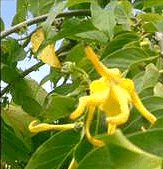

 Family
Annonaceae (Compositae)
Family
Annonaceae (Compositae)
Endocrine System: Can support hormone balance (Shute)
Nervous System: Stress relief.
Reproductive System: YlangYlang mixed with jasmine or rose has been used to treat sexual difficulties, especially those stemming from lack of confidence and/or inhibition. It is useful in treating PMS and menopausal mood swings, especially when mixed with Clary..
Muscular System: Useful in a blend to ease muscle spasms and tense muscles
Digestive System: Calminative. Useful for stress related digestive problems, especially.
Respiratory System: Ylangylang is said to be useful in treating abnormally fast breathing, and palpitations. (Lawless)
Skin: Anti-seborrheic, antiseptic. Promotes healing of wounds. In a facial oil or cream, it can help balance sebum production and is most helpful to oily skin. It also can fight the bacteria that often contribute to acne.
Other:
It has traditionally been used in hair tonics and is believed to stimulate hair growth.
At the turn of the century it was used to treat malaria and other tropical fevers. (Battaglia)
Recent research indicates that inhaling ylangylang before the onset of a seizure may help control epilepsy.
It is known in Asia as an antidepressant, relaxing to body, mind and spirit, as well as an aphrodisiac.
It is said to calm anger, release tension, lift depression and generally stabilize mood swings.
Julia Lawless recommends it for frustration borne of anger.
Ylangylang Extra is most commonly used in perfumery, while ylangylang 2 or 3 are more apt to be used in soap and skin products. The scent becomes lighter and less heady as you go down the scale.
Energy:
Cool & Moist:
Chakra:
2,3
Return to
TOP
Return to
AGORA Index
Return to Agora
Main Page
This page written by Marge Clark
This page hosted by
Nature's Gift Aromatherapy
So is it Ylangylang, Ylang Ylang, or Ylang-ylang? Not even the search engines know for sure. Google gives about the same information and rankings for all three spellings. When this article was originally written, the author used ylangylang, but on her website today she has both ylang ylang and ylangylang. The space version drives spell checkers crazy by insisting it is a duplicate. I've left the spelling alone in this upgrade. Just call it Cananga odorata?-rs
This article has been adopted to our new format from the original that still resides on naturesgift.com.
-Michel Vanhove
AGORA Pages originally hosted on these now dead sites are now hosted on the AGORAIndex.org site when available:
- benzalco.com
- aromavitae
- aromatours
- FragrantDemon
Like us on Facebook at [Coming soon]
View our Twitter feed on this page.
©Aromatherapy Global Online Research Archive and it's individual authors. All Rights Reserved.